Biographical data
He was active in Leuven between 1595 and 1606, and it is highly likely that he was a relative of the publishers and typographers Petrus (1559–1623) and Philippus Zangrius (1585–1610).
In 1601, Zangrius engraved portraits of Infante Isabella, her husband Archduke Albrecht Habsburg, the governor of the Low Countries, and Justus Lipsius. These engravings were also included in his 1602 (or 1605) work titled Album Amicorum, which contained a total of 67 engravings. Among these were 46 depictions of womanly costumes and armorial cartouches, as well as 9 smaller and 11 larger armorial engravings.
This work stands as one of the earliest examples of heraldic pavilions likely following the style of Jean-Jacques Boissard. The small armorial shields remain unadorned. The depictions of womanly costumes were engraved based on the tables created by Julius Goltzius, which can be found in the following publication: Jean Jacques Boissard, Habitvs Variarvm Orbis gentium. Habitz de Nations estra:[n]ges. Trachten mancherley Voelcker des Erdskreysz, Cum Priuilegio Caesaro, Cum Priuilegio Regio, 1581 [Mechelen, Caspar Rutz].
Zangrius in heraldry
According to some authors, Zangrius developed the earliest hatching system in heraldry, identical with the present day hatching method, seen on his armorial chart of Brabant. (Jean Baptiste Zangre, Representation de l'Ancienne et Souveraine Duche de Brabant, ses Villes, Dignitez et Dependences, Comme Lothier, Limborghe et Pays de Outre Meuse, Louvain, 1600. Measures: 49 x 56.3 cm). Though manufactured by Arnold van Rincvelt, it is better known as the armorial chart of Zangrius. The original chart is held by the Helmond Castle-Townhall.
The armorial chart of Zangrius was first published in the 81st volume (1964) of the De Nederlandsche Leeuw by F. J. van Ettro. He maintains that the present-day hatching system was invented by Zangrius. The historical background for the coming into existence of the armorial chart was the 6 March 1598 edict of the Spanish king Philip II who detached the Low Countries in his testament from Spain and gave independence to the Netherlands on the occasion of the marriage of his daughter Infante Isabella to archduke Albrecht Habsburg who served as the governor of the province since 1596. The princely consorts marched across Brussels ceremoniously on 5 September 1599. As Albrecht Habsburg died in 1621 without heirs, the country returned to the Spanish crown, as was stated in the treaty. (For another engraving from 1623, portraying Albrecht's funeral procession, see the picture taken from Jacob Franquart.) Albrecht's proclamation of the sovereignty was illustrated by numerous armorial charts published by several cities and noblemen of the Low Countries, and the armorial chart of Zangrius held in the Helmond Castle-Townhall is one of them.
F. J. van Ettro maintained: "Particularly noteworthy about this chart is, that the metals gold and silver, and the colours red, blue, green and black, are rendered according to the same system of hatching by means of dots and stripes, as is being used to this day in modern heraldry" (op. cit. p.211).
However, the hatching systems of Silvester Petra Sancta (1638) and Marcus Vulson de la Colombière (1639), respectively differ from the method developed by Zangrius in the way of hatching of the colour Sable. Thus, it almost seems evident that Petra Sancta or de la Colombière modeled their systems after Zangrius' hatching table.
Zangrius inscribed into the oval escutcheon of his hatching table both the heraldic and standard French language appellations of the given tinctures as follows – Or, Argent, Geulle [gueules] and Rouge (gules), Azur and Bleu (azure), Sinople and Verd [Vert] (vert). The hatching used by him for these tinctures is identical with contemporary hatching methods. The only difference in Zangrius' system was the hatching of the colour sable (Sable and Noir by Zangrius), i.e. crossing of vertical and diagonal lines from the heraldic left to right instead of the present day's crossing of vertical and horizontal lines.

Marcus Vulson de la Colombière or Sieur de la Colombière was a French heraldist, historian, poet and member of the royal court. His name is sometimes spelled as Wulson or Volson.

Silvester Petra Sancta was an Italian Jesuit priest, and heraldist. His name is also spelt as Sylvester Petra Sancta, Petrasancta, in Italian Padre Silvestro da Pietrasanta. Pseudonym: Coelius Servilius

Hatching is a conventional system for monochrome denotation of heraldic armory, whereby the tinctures (colours) are represented by dots and lines. This technique is employed in cases where colours, for either aesthetic, practical or economic reasons are not reproduced – e.g. on surfaces such as woodcuts or engravings, seals and coins.
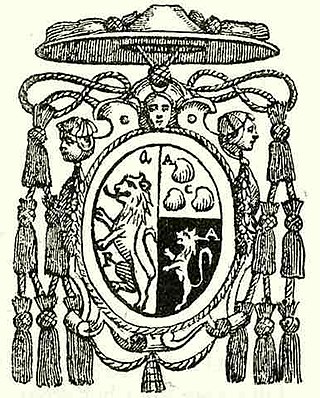
Tricking is a method for indicating the tinctures (colours) used in a coat of arms by means of text abbreviations written directly on the illustration. Tricking and hatching are the two primary methods employed in the system of heraldry to show colour in black and white illustrations.
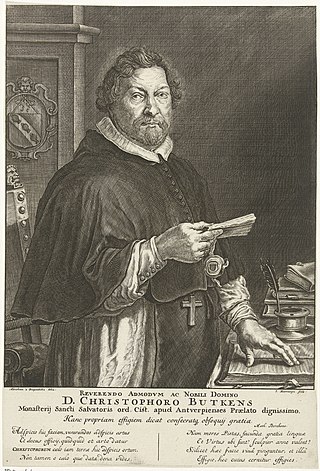
Christophe Butkens (1590–1650) was a Cistercian abbot from Antwerp, a historian and a genealogist who developed a new hatching system.
Philippe de L'Espinoy (1552–1633) of Ghent was a historian, genealogist and heraldist of the Low Countries.
Johan Faber, anglicized as John Faber, commonly referred to as John Faber the Elder, was a Dutch miniaturist and portrait engraver active in London, where he set up a shop for producing and marketing his own work. His son John Faber the Younger was also active in this field.
Wouter Abts was a Flemish painter, born at Lier, near Antwerp, possibly in 1582. He was a pupil of Willem de Vos. Little is known about his life. He was admitted as a master to the Guild at Antwerp in 1604–5; and he died in 1642–43. He mainly painted genre pieces, but a winter landscape has been attributed to him. He taught Adrian de Bie and Lenaert Coomans.

Pieter Snyers or Peter Snijers was a Flemish art collector, painter, draughtsman and engraver. He practised a wide variety of genres, including portraits, genre painting, still life and landscape painting. His masterpiece is a series of 12 paintings, each representing a different month of the year.

Theodorus van Pee (1668–1746) was an 18th-century painter and art dealer from the Dutch Republic.

Salomon Leonardus Verveer was a Dutch marinist and landscape painter. He was one of the most versatile and successful artists at the time of the Dutch romance, both at home and abroad. His sepia gouache and drawings are much appreciated. He is buried at the old Scheveningseweg Jewish cemetery in The Hague. His tomb, a large sarcophagus resting on a catafalque, is one of the most striking monuments in this historic cemetery.

Jan Collaert II or Hans Collaert II was a Flemish engraver and printmaker working in Antwerp around the turn of the 17th century. Collaert also published under the name Jan Baptist Collaert.
Jan Baptist Francken was supposed to be a painter from the Francken family and/or the son of Sebastian Vrancx, but is now considered to have been an error and to have never existed. The confusion was created by the many painters named Francken, some poor attributions, and a portrait by Anthony van Dyck of a certain Johannes Baptist Franck, aged 32, of whom nothing more is known. He is sometimes said to be the same as Hans Francken, another obscure member of the same family.
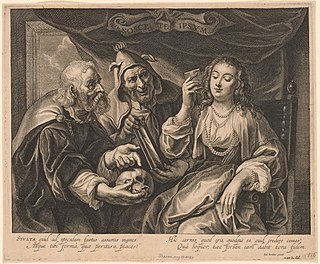
Jacob Neefs or Jacob Neeffs was a Flemish etcher, engraver and publisher. He worked on publication projects for prominent Flemish artists of his time including Rubens, van Dyck and Jacob Jordaens.
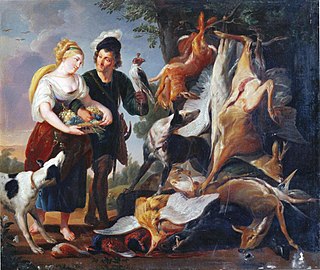
Pieter Jan Snyers or Petrus Johannes Snijers, first name also 'Peeter Johannes' was a Flemish painter. He is known for his still life paintings with game.

Susanna de La Croix (1755–1789) was a Dutch painter.

Peter Henricus Theodorus (Pierre) Tetar Elven was a Dutch painter, draftsman, etcher, watercolorist and panorama painter of the 19th century. He had a preference for architecture, landscapes, and Italian cityscapes (vedutas). He also painted a few genre pieces for French high society.
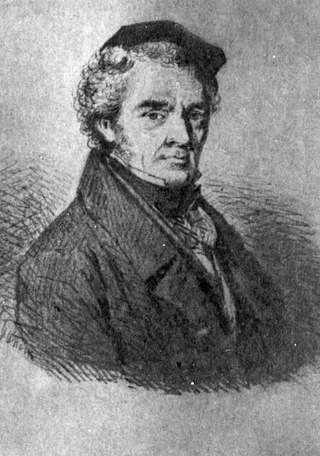
Casparis Haanen was a Dutch painter, paper cutter and draftsman.

Valentijn Bing was a Dutch painter, illustrator, and lithographer. His works included genre scenes, religious art, portraits, and cityscapes.

Louis Henri de Fontenay, also known as Ludovicus Henricus de Fontenaij, was a Dutch painter, draftsman, and lithographer.





















